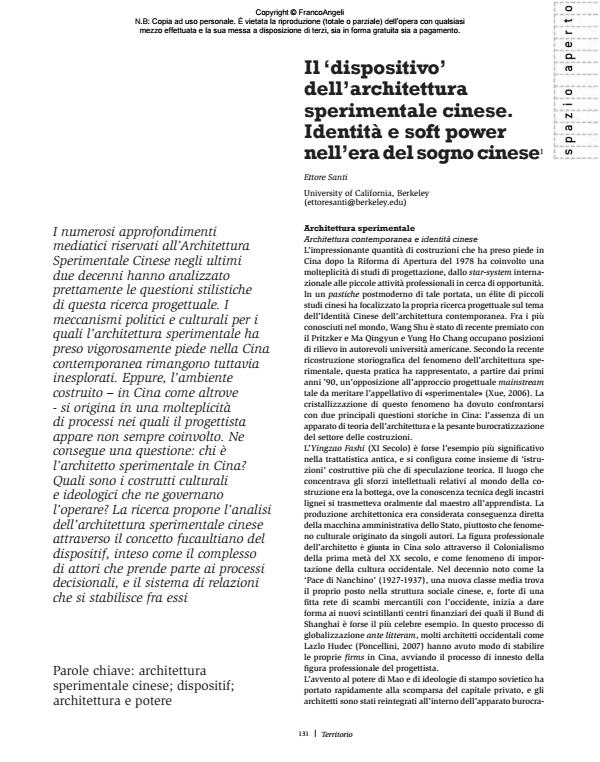Il ‘dispositivo’ dell’architettura sperimentale cinese. Identità e soft power nell’era del sogno cinese
Titolo Rivista TERRITORIO
Autori/Curatori Ettore Santi
Anno di pubblicazione 2016 Fascicolo 2016/76 Lingua Italiano
Numero pagine 10 P. 131-140 Dimensione file 418 KB
DOI 10.3280/TR2016-076018
Il DOI è il codice a barre della proprietà intellettuale: per saperne di più
clicca qui
Qui sotto puoi vedere in anteprima la prima pagina di questo articolo.
Se questo articolo ti interessa, lo puoi acquistare (e scaricare in formato pdf) seguendo le facili indicazioni per acquistare il download credit. Acquista Download Credits per scaricare questo Articolo in formato PDF

FrancoAngeli è membro della Publishers International Linking Association, Inc (PILA)associazione indipendente e non profit per facilitare (attraverso i servizi tecnologici implementati da CrossRef.org) l’accesso degli studiosi ai contenuti digitali nelle pubblicazioni professionali e scientifiche
I numerosi approfondimenti mediatici riservati all’Architettura Sperimentale Cinese negli ultimi due decenni hanno analizzato prettamente le questioni stilistiche di questa ricerca progettuale. I meccanismi politici e culturali per i quali l’architettura sperimentale ha preso vigorosamente piede nella Cina contemporanea rimangono tuttavia inesplorati. Eppure, l’ambiente costruito - in Cina come altrove - si origina in una molteplicità di processi nei quali il progettista appare non sempre coinvolto. Ne consegue una questione: chi è l’architetto sperimentale in Cina? Quali sono i costrutti culturali e ideologici che ne governano l’operare? La ricerca propone l’analisi dell’architettura sperimentale cinese attraverso il concetto fucaultiano del dispositif, inteso come il complesso di attori che prende parte ai processi decisionali, e il sistema di relazioni che si stabilisce fra essi;
Keywords:Architettura sperimentale cinese; dispositif; architettura e potere
- Adorno T., 1984, Aesthetic Theory. London: Routledge & Kegan Paul.
- Agamben G., 2009, What Is An Apparatus? Stanford, CA.: Stanford U.P.
- Ai J., 2006, «Guanxi Networks In China: Its Importance And Future Trends». China & World Economy, 4, 14, 105-118. DOI: 10.1111/j.1749-124X.2006.00034.x
- Asianlii.org, 2014, Regulations on Urban Real Estate Development and Management Control. www.asianlii.org/cn/legis/cen/laws/rouredamc613/#5.
- Bates G., Huang Y., 2006, «Sources and Limits of Chinese ‘Soft Power’ ». Survival: Global Politics and Strategy, 48, 2: 17-36. DOI: 10.1080/00396330600765377
- Cai Y., Cui L., 2013, The Roles of Universities In Chinese Regional Innovation Systems. An Re-Examination of the Triple Helix Model. Lecture in «Regional Studies Association European Conference 2013: Shape and be Shaped. The Future Dynamics of Regional Development». Finland: University of Tampere, May 5th-8th.
- Cook P., 1970, Experimental Architecture. New York: Universe Books.
- de Muynck B., 2006, «Architect in China. An Interview with Qingyun Ma of Mada Spam». Ubitiquous China, 8.
- de Muynck B., 2011, «Major Forces. An Interview with Sun Jiwei». mark, 31.
- Ding G., 2013, Constructing a Place of Critical Architecture in China: A Case Study of the Journal Time + Architecture. University of Nottingham: Ph.D. Thesis.
- Etzkowitz H., 2008, The Triple Helix. New York: Routledge.
- Feng J., 2006, The Song-dynasty Imperial ‘Yingzao Fashi’ (Building Standards, 1103) and Chinese Architectural Literature: Historical Tradition, Cultural Connotations, and Architectural Conceptualization. Providence, RI.: Brown University.
- Foucault M., Colin G., 1980, Power/Knowledge. New York: Pantheon Books.
- Gregotti V., 2012, Incertezze e simulazioni. Milano: Skira.
- Gold T., Guthrie D., Wank D., 2002, Social Connections in China: Institutions, Culture and the Changing Nature of Guanxi. Cambridge: Cambridge U.P.
- Iritani E., 2004, «Great Idea But Don’t Quote Him; Deng Xiaoping’s Famous One-Liner Started China on the Way to Capitalism. The only Problem is There’s no Proof he Actually Said it». Los Angeles Times, September 9th.
- Larmer B., 2012, «Building The American Dream In China». New York Times Magazine, March 3rd. www.nytimes.com/2012/03/18/magazine/architects-in-china-building-the-american-dream.html?pagewanted=all&_r=0.
- Larsen T., 2004, «Doing Business in China: A Primer for the Daring, Shrewd, and Determined Practice Matters». Architectural Record, 03.04: 1-2.
- Lawrence S., Martin M.F., 2012, Understanding China’s Political System. Washington, DC.: Congressional Research Service.
- Li F., 2010, Critical Practice in State-Owned Design Institutes in Post-Mao China (1976-2000): A Case Study of cag. Melbourne: University of Melbourne, Master Thesis.
- Li X., 2008, «Make-the-Most-of-It’Architecture». City, 12, 2: 226-236. DOI: 10.1080/13604810802167010
- Li X., 2011, «Key Concepts of Chinese Architecture Today». A.V. Monografias, 150: VII-VIII.
- Mao Q., 2011, Urban Planning and Management in China. The State of China’s Cities, 2010/2011.
- Nye J., 2004, Soft Power: The Means to Success in World Politics. New York: Public Affairs (trad. it., 2005, «Soft Power». Torino: Einaudi).
- Poggioli R., 1962, Teoria dell’arte d’avanguardia. Bologna: il Mulino.
- Poncellini L., 2007, Lazlo Hudec in Shanghai (1919-1947). The Brilliant Trajectory of an Hungarian Architect in the Process of Modernization of the Greatest Cities of the East. www.hudecproject.com/files/l_poncellini_article.pdf.
- Ren X., 2011, Building Globalization: Transnational Architecture Production in Urban China. Chicago: The University of Chicago Press.
- Shambaugh D., 2015, «China’s Soft Power Push. The Search for Respect». Foreign Affair. www.foreignaffairs.com/articles/china/2015-06-16/china-s-soft-power-push.
- Shin H.B., 2014. «Contesting Speculative Urbanisation and Strategising Discontents». City: Analysis of Urban Trends, Culture, Theory, Policy, Action, 18: 4-5, 509-516. DOI: 10.1080/13604813.2014.939471
- Tian L., Wenjun Ma., 2009, «Government Intervention in City Development of China: A Tool of Land Supply». Land Use Policy, 26, 3: 599-609. DOI: 10.1016/j.landusepol.2008.08.012
- Xue C.Q.L., 2006, Building a Revolution. Chinese Architecture Since 1980. Hong Kong: Hong Kong U.P.
- Zhu J., 2009, Architecture of Modern China: A Historical Critique. London: Routledge.
Ettore Santi, Il ‘dispositivo’ dell’architettura sperimentale cinese. Identità e soft power nell’era del sogno cinese in "TERRITORIO" 76/2016, pp 131-140, DOI: 10.3280/TR2016-076018